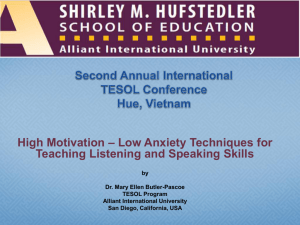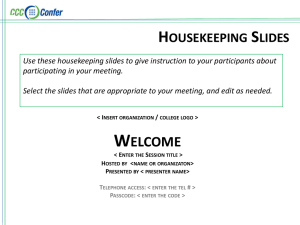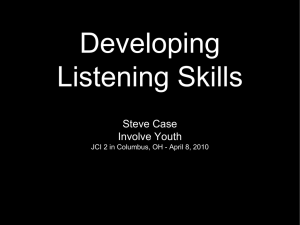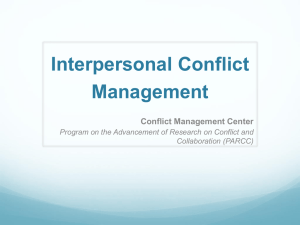slide
advertisement
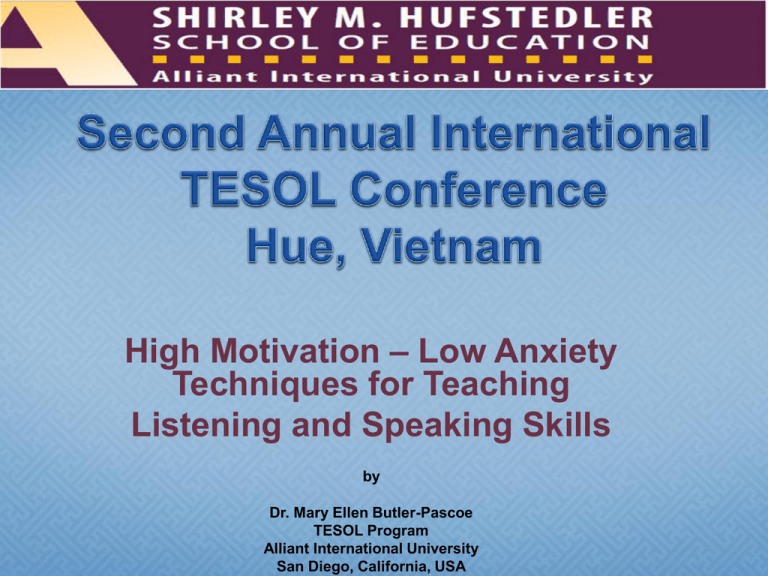
High Motivation – Low Anxiety Techniques for Teaching Listening and Speaking Skills by Dr. Mary Ellen Butler-Pascoe TESOL Program Alliant International University San Diego, California, USA • A key role of the of the second language teacher is to act as a facilitator in providing comprehensible input to assist students in converting “input “ into “intake” • Listening is a critical receptive skill that typically precedes productive ability (such as speaking) • In the language classroom and outside the class, students engage more in listening than they do in speaking. Cashier Why can't this customer understand what I'm saying? I have repeated "forhereortogo" three times. I even said the words very slowly the last time. He must not understand any English. Customer What does ‘forhereortogo’ mean? Even when the cashier asks me slowly, I understand the words but I don’t know what the words mean. “ Helpful English-speaking Customer - “For here or to go?” The cashier wants to know if you would like to eat your food here in the restaurant or would you like it to go home with you. Is your food for here or to go home? • Integrate listening practice into the class. Don’t assume comprehension competence “just happens”—Allow more listening time. • Include both global (gist of message) and focused listening (form and accuracy). • Appeal to students’ intrinsic motivation. Include students’ interests, goals and abilities. • Use authentic language in meaningful contexts. Highlight relevance to real-life needs. • Consider how students will respond. Listening cannot be seen; we must infer students’ comprehension from their responses • Teach conscious listening strategies for beyond the classroom. Listen for key words, guess at meaning, observe non- verbal cues; seek clarification; guess at meaning from context, listen for general ideas; listen for details. • Engage both bottom-up (linguistic knowledge) and top-down (background knowledge) listening processes. • Focus on fluency and accuracy in speaking (depending on lesson/activity objective). • Provide appropriate feedback and correction. • Optimize the natural link between listening and speaking. • Give students the opportunity to initiate oral communication. • Develop speaking strategies: Using fillers (“Well,” “Um,”); using conversation maintenance cues (“uh-huh,” “right,” “yeah,” “okay”); getting someone’s attention (“Excuse me”). • • • • • • • • • • • • Information gap activities Games Jigsaw tasks Ranking exercises Discussions Real-world tasks Problem-solving activities Internet activities (WebQuests) Role plays Charts and timelines Songs, plays, poems Chat Technology provides Low affective filter—decreases anxiety. Collaboration—provides opportunities for using the language for negotiation and for group activities. Motivating activities to stimulate discussion—inspires students to communicate via and around the computer. Different Learning styles—Multimedia meets needs of all learners (Visual, kinesthetic, aural, etc.). Feedback and Assessment --Students can listen, record and/or store oral communication and receive feedback. (VoiceThread, podcasts, etc.). Examples: Breaking News English (Listening) QuestGarden (Task-based listening and speaking) VoiceThread (Speaking and feedback) Hot Potatoes (Integrated skills) Podomatic (Speaking via podcasts) Randall’s ESL Cyber Listening Lab (Listening) TEFL/TESL/TESOL Links (Listening and Speaking/Pronunciation) PRINT 13-Page PDF Handout LISTEN MP3 (2:00 - 963KB) QUIZZES Fill-in-the-blank Matching Hangman Flash cards Sentence jumble Missing words No letters Crossword A VoiceThread is a collaborative, multimedia slide show that holds images, documents, and videos Allows people to navigate slides and leave comments in 5 ways - using voice (with a microphone or telephone), text, audio file, or video (via a webcam). Share : A VoiceThread with friends, students, and colleagues for them to record comments too. A WebQuest is an task-based activity designed by teachers that uses webpages to present the task to the students. Example: Exploring Cultures from Around the World http://www.ouralliant.com/edu6072/su09/aschorr/webquest/ The Webquest has several components: Introduction Task Process Evaluation Conclusion Teacher’s Page PowerPoint available at faculty webpage of Dr. Mary Ellen Butler-Pascoe, mbutler@alliant.edu Professor and Director of TESOL Master’s and Doctorate Programs Alliant International University Shirley M. Hufstedler School of Education San Diego California, USA http://www.alliant.edu/
